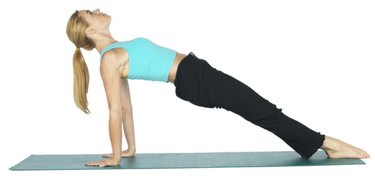
An epigastric hernia occurs in your upper abdomen when a bit of your peritoneum, or lining of your stomach cavity, peers through a separation in the muscle wall. Epigastric hernias are less common than hernias in the lower abdomen, with only a 0.5 percent prevalence rate, according to K.M Erickson of Sonographers.ca. More men than women have these, at a ratio of about 3 to 1. You may have had your epigastric hernia since you were born. A reducible hernia may appear and disappear.
Location
Video of the Day
Exercise that strains your upper abdominal muscles should be avoided when your epigastric hernia is not reduced. These are the same muscles used when you sneeze or cough. Take care when performing any exercises involving the muscles between your sternum and your navel, where your epigastric hernia is located. You may even be able to see your epigastric hernia when you begin to do a situp. Certain yoga positions can aggravate your epigastric hernia, especially those that make you red in the face.
Video of the Day
Exercise and Repair
No exercises exist for the treatment for epigastric hernia. Only your surgeon can effectively treat your epigastric hernia. She will suture small hernias closed or use a wire mesh to contain large hernias. Exercise is vital to your health in the days following epigastric hernia repair. The Comprehensive Center for Laparoscopic Surgery reports that it is extremely important that patients begin moving the day after epigastric hernia repair to reduce the risk for developing postoperative complications such as pneumonia, deep venous thrombosis and pulmonary embolism. Early therapy will focus on exercises to quickly return you to your usual activities of daily living.
Post Surgical Therapy
Epigastric hernia repair using minimally invasive techniques like laparoscopic surgery requires very little postoperative physical therapy. Postsurgical exercises are designed to help you get out of bed and return to a normal life. In the first two days after surgery, therapists will help you strengthen the muscles you need to move from a laying position to sitting at the edge of the bed. Next, he will help you regain the power to move from a seated position to standing. Repeat these exercises several times each day.
General Exercise
All hernia patients, before and after repair surgery, should avoid heavy lifting and straining and are encouraged to use proper body mechanics. Do not perform any strenuous exercise for two weeks after surgery. Avoid exercises that put pressure on your upper abdominal muscles, like those you might use when bearing down for a bowel movement. Situps, weightlifting and some yoga positions use these muscles.
Is this an emergency? If you are experiencing serious medical symptoms, please see the National Library of Medicine’s list of signs you need emergency medical attention or call 911.